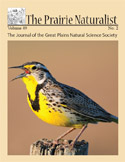Great Plains Natural Science Society

The Prairie Naturalist
Date of this Version
12-2013
Document Type
Article
Citation
The Prairie Naturalist 45(2): 109-113. December 2013
Abstract
Factors that affect nest site selection in red-tailed hawks (Buteo jamaicensis) include the physical features surrounding the nest and landscape characteristics. Features surrounding nests include: tree height, tree diameter (dbh), percent canopy cover, slope, nest openness, and density of woody plants or shrubs (Titus and Mosher 1981, Bechard et al. 1990, Tietje et al. 1997, Actkinson et al. 2007). Landscape characteristics that influence nest-site selection by red-tailed hawks vary across regions. In Georgia, red-tailed hawks selected nest site in areas with greater area of agriculture and open pasture (Moorman and Chapman 1996), whereas in Oklahoma prairies, the hawks selected nest sites in landscapes with greater wooded area (McConnell et al. 2008). In Wisconsin, a greater high-density urban habitat and road area along with small patch sizes correlated with greater nest productivity (Stout et al. 2006). In the sagebrush grasslands of Oregon, dispersion and density of perches resulted in increased nest productivity (Jaynes 1984).
Included in
Biodiversity Commons, Botany Commons, Ecology and Evolutionary Biology Commons, Natural Resources and Conservation Commons, Systems Biology Commons, Weed Science Commons


Comments
Published by the Great Plains Natural Science Society, 2013. Used by permission.